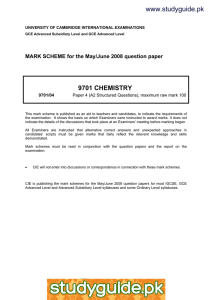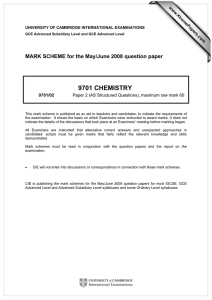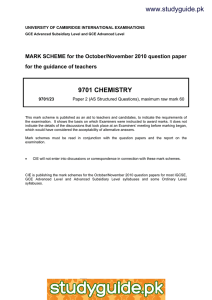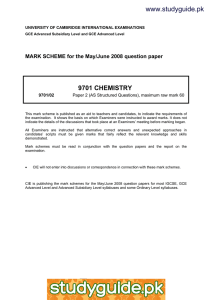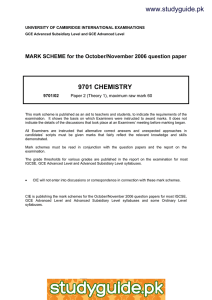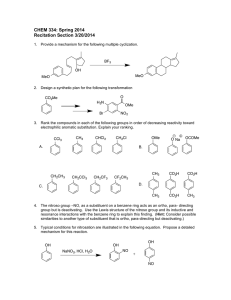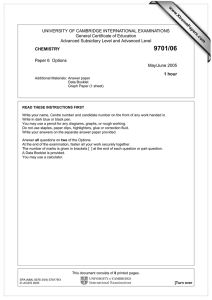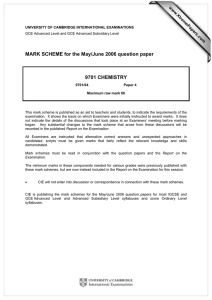9701 CHEMISTRY MARK SCHEME for the May/June 2008 question paper
advertisement
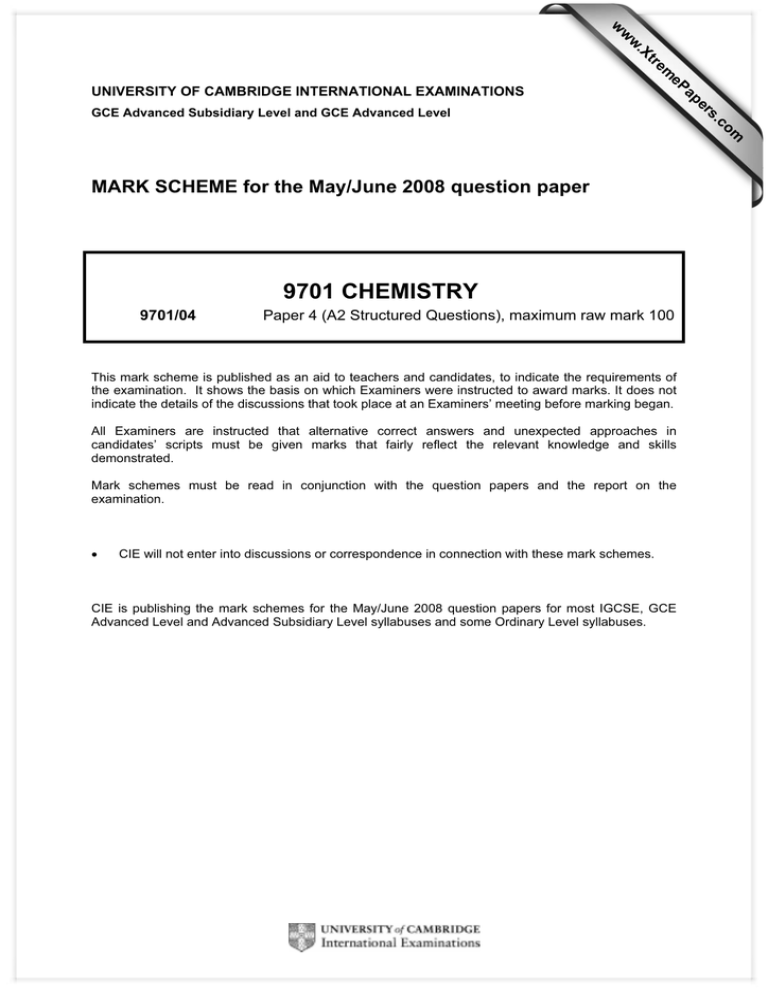
w w ap eP m e tr .X w UNIVERSITY OF CAMBRIDGE INTERNATIONAL EXAMINATIONS 9701 CHEMISTRY 9701/04 Paper 4 (A2 Structured Questions), maximum raw mark 100 This mark scheme is published as an aid to teachers and candidates, to indicate the requirements of the examination. It shows the basis on which Examiners were instructed to award marks. It does not indicate the details of the discussions that took place at an Examiners’ meeting before marking began. All Examiners are instructed that alternative correct answers and unexpected approaches in candidates’ scripts must be given marks that fairly reflect the relevant knowledge and skills demonstrated. Mark schemes must be read in conjunction with the question papers and the report on the examination. • CIE will not enter into discussions or correspondence in connection with these mark schemes. CIE is publishing the mark schemes for the May/June 2008 question papers for most IGCSE, GCE Advanced Level and Advanced Subsidiary Level syllabuses and some Ordinary Level syllabuses. om .c MARK SCHEME for the May/June 2008 question paper s er GCE Advanced Subsidiary Level and GCE Advanced Level Page 2 1 Mark Scheme GCE A/AS LEVEL – May/June 2008 Syllabus 9701 (a) (i) A is Cl2/chlorine Paper 04 [1] B is NaCl or HCl or Cl ¯ [or words], etc. [1] C is salt bridge or KCl/KNO3, etc. [1] D is platinum/Pt [1] E is Fe2+ + Fe3+ or mixture of Fe(II) + Fe(III) salts [1] mention of standard conditions ([Cl ¯] of 1 mol dm–3 or Cl2 at 1 atmos or T = 25°C/298 K) [1] (ii) Eo = EoR – EoL= 0.77 – 1.36 = (–)0.59 (V) (ignore sign) [1] (since R.H. electrode is negative) electrons flow (from right) to left or to the chlorine electrode or anticlockwise or from (beaker) E to (beaker) B [1] [8] (b) (i) ∆H = 3 ×(–167.2) + (–48.5) – (–399.5) = –150.6 or 151 (kJ mol–1) (correct ans [2]) (ii) 2Fe3+ + Cu → 2Fe2+ + Cu2+ (or molecular: 2FeCl3 + Cu → 2FeCl2 + CuCl2) Eo = 0.77 – 0.34 = (+) 0.43 (V) (no mark for –0.43V) [1] [1] [1] [1] [4] [Total: 12 max 11] 2 (a) (i) ∆H = 4 × 278 – 244 – 2 × 496 = –124 (kJ mol–1) (correct ans [2]) [1] [1] (ii) shape is bent/V-shaped/non-linear (or diagram) [1] due to (one) lone pair and/or (1) odd/unpaired electron (or shown on diag) [1] (assume electrons are on chlorine unless explicitly stated otherwise, in which case award no mark) (iii) 3KClO3 + H2SO4 → K2SO4 + KClO4 + H2O + 2ClO2 [1] [5] (b) (i) coal-fired power stations; fuel in cars; car exhausts/gas emissions; other named use of a fossil fuel; contact process; cement manufacture; brick manufacture; roasting of sulphide ores; burning tyres (any 2) [1] (NOT volcanoes etc; NOT burning of natural gas) (no marks for only 1 correct source) (ii) causes acid rain [1] which lower pH of lakes; leaches aluminium from soils; kills fish/plants/rainforests; dissolves/corrodes/damages buildings (any 1) [1] (NOT asthma etc – since this is not environmental) [3] © UCLES 2008 Page 3 Mark Scheme GCE A/AS LEVEL – May/June 2008 Syllabus 9701 (c) (i) CO2: simple + molecular/covalent or weak intermolecular forces SiO2: giant/macro + molecular/covalent SnO2: ionic/electrovalent (ignore “giant”) (2 correct = [1], 1 correct = [0]) Paper 04 (all 3 correct) [2] (ii) SnO2 is stable, PbO2 is not or SnO2 is the more stable PbO2 → PbO + ½ O2 [1] [1] (iii) H2O + CO2 (⇌) H+ + HCO3¯ Kc = [H+][HCO3¯]/[H2O][CO2] or = [H+][HCO3¯]/[CO2] [1] ecf [1] (iv) HCO3¯ + H+ → H2CO3 or H2O + CO2 (or equation with H3O+) HCO3¯ + OH¯ → CO32- + H2O (NB NOT H2CO3 + OH¯ →) [1] [1] (words can substitute for one of the equations but not both. If two correct word descriptions are given, in the absence of at least one correct equation, award [1] mark only) [8] [Total: 16 max 15] 3 (a) tetrahedral diagram (either dashed+wedge, or similar representation) angles (all) 109° – 110° (award [0] for part (a) if an angle of 90° or 180° is mentioned) (b) volatility decreases or boiling points increase (allow b.pt. CCl4 > SiCl4 but b.pt. increases thereafter) due to greater van der Waals’/intermolecular forces or due to more electrons (mention of “ions” negates this mark) (c) (i) Pb4+/Pb2+: E o = +1.69V, Sn4+/Sn2+: E o = +0.15V, a valid comment about relative redox power or stability, e.g.: (hence) Sn2+ easily oxidised or Sn4+ is more stable than Sn2+ or Pb4+ is easily reduced or Pb2+ is more stable than Pb4+ or +2 oxidation state more stable down the group (ii) Sn2+ + I2 → Sn4+ + 2I ¯ Pb4+ + SO2 + 2H2O → 4H+ + SO42- + Pb2+ (N.B. no marks in (ii) for E o values) (d) (i) for Si: ∆H = 244 – 2(359) = –474 (kJ mol–1) for Sn: ∆H = 244 – 2(315) = –386 (kJ mol–1) (allow [1] out of [2] salvage mark for 474 & 386; 962 & 874; or –962 & –874) (ii) Yes: the +4 state becomes decreasingly stable – the ∆H is less exothermic (mark is for relating ∆Hs to stability: allow ecf from d(i) and also from c(i)) [1] [1] [2] [1] [1] [2] [both] [1] [1] [1] [1] [4] [1] [1] [1] [3] [Total: 11] © UCLES 2008 Page 4 4 Mark Scheme GCE A/AS LEVEL – May/June 2008 Syllabus 9701 (a) ester Paper 04 [1] [1] (b) reaction I: acid/H+/HCl/H2SO4 or alkali/OH¯/NaOH (followed by H+) [1] heat/reflux and aqueous (allow H3O+ to equal H+ + aq, also assume “conc” or “dil” means aq (but NOT H2SO4) also allow aqueous ethanol) [1] (for heat: allow T ≥ 80°C; not “warm”) reaction II: methanol/CH3OH heat with conc. H2SO4/H3PO4 or HCl(g) [NOT conc HCl] (c) (i) BrCH2-CHBr-CH2Br [1] [1] [4] [1] (ii) HO2C-CO-CO2H [1] [2] (d) 890g of triglyceride produces 3 × 298 = 894g of biodiesel ∴ 500kg produces 500 × 894/890 = 502kg biodiesel (correct ans [2]) (1004/1005kg or 167kg is worth [1]: 333kg is worth [0]) (e) (i) C17H35CO2CH3 + 27.5 O2 → 19CO2 + 19H2O (or C19H38O2) (ii) 10 × 44 × 19/298 = 28.(05)/28.1kg (–1 for each error) some ecf values: n = 18 ⇒ 26.6kg n = 17 ⇒ 25.1kg (allow [2] for each) n = 16 ⇒ 23.6kg [1] ecf [1] [2] [1] ecf from equ [2] [3] (f) any one of the following. • (saving) diminishing resources • economic argument (NOT just “cheaper”) – e.g. oil will become increasingly more expensive as it runs out • ref to CO2 cycle (e.g. no net increase in CO2, i.e. “carbon neutral”) or less global warming (due to a smaller carbon “footprint”) • renewable/sustainable • the effect of biofuel cultivation on world food prices [1] [1] [Total: 13] © UCLES 2008 Page 5 5 (a) reaction I Mark Scheme GCE A/AS LEVEL – May/June 2008 Syllabus 9701 Paper 04 electrophilic addition [1] reaction II electrophilic substitution (salvage: award [1] out of [2] for “addition” + “substitution”, even if nucleophilic) (b) reaction I: intermediate [1] [2] [1] Br CH2 CH2 H2C or CH2 Br second step, attack of Br¯ on bromocation. Br CH2 CH2 [1] H2C or CH2 Br Br Br reaction II: intermediate [1] H Br H Br or (make sure ⊕ is not at sp3 C-atom) (or with ⊕ in 2-position) second step, loss of H+ from bromocation. H Br [1] H Br or [4] (c) Delocalised ring of electrons (in benzene) is stable, (so is re-formed in second step in benzene.) or electrons in the ethene π bond are localised/more available for reaction with electrophiles [1] [1] [Total: 7] © UCLES 2008 Page 6 Mark Scheme GCE A/AS LEVEL – May/June 2008 Syllabus 9701 Paper 04 6 CH3 CO2H Br CO2H Br A B CO2H CO2H NO2 NH2 D C E 5 x [1] [deduct [1] mark if ring circle omitted more than once] [allow ecf for E from structure of D] [allow ecf for B from structure of A] [allow -CO2¯ for E] [5] [Total: 5] 7 polymer addition/condensation? 1 condensation formulae of monomers HO2C-CO2H or ClCO-COCl NH2-CH2-CH2-NH2 HO-CH2-CH(C2H5)-CO2H 2 condensation HO-CH2-CH(CH3)-CO2H 3 CH2=CH-CH3 CH2=CH-CONH2 CH2=CH-C6H5 addition ⇑ [2] (2 correct: [1]) ⇑ [6] (6 correct: [5]) etc (2 correct: [1]) (C=C bonds not needed, but penalise –[1] if C-C drawn instead of C=C) (if more than 7 formulae drawn, then penalise –[1] for each formula in excess of 7) [8] [Total: 8] © UCLES 2008 Page 7 8 (a) primary: Mark Scheme GCE A/AS LEVEL – May/June 2008 Syllabus 9701 Paper 04 covalent (ignore amide, peptide etc) diagram showing peptide bond: (-CHR-)CONH(-CHR-) [1] [1] secondary: hydrogen bonds (NOT “..between side chains”) diagram showing N-H···O = C tertiary: [1] [1] two of the following: • hydrogen bonds (diag. must show H-bonds other than those in α-helix or β-pleated sheet – e.g. ser-ser) • electrostatic/ionic attraction, • van der Waals’/hydrophobic forces/bonds, • (covalent) disulphide (links/bridges) [1] + [1] suitable diagram of one of the above (for disulphide: S-S not S=S or SH-SH) [1] [7] (b) met-ala-gly-ala-gly-arg-val-lys [2] any possible sequence with more than 8 residues, that “uses” all 6 tripeptides (overlapping or not), and that starts with met and ends with lys is worth [1] mark any sequence that does not start with met or end with lys gets zero. [2] (c) CARE – this is not about DNA! candidates should describe TWO potential effects on tertiary or quaternary structures caused by amino acid sidechains... these include: disruption of H-bonding disruption of disulphide bridges disruption of electrostatic/ionic attraction disruption of van der Waals’ forces (only allow effects on the secondary structure if proline is specifically mentioned) 2 x [1] then award [1] mark each for two of the following bullet points: • a description of the amino acids involved in the above, (or a labelled diagram) (award [1] mark for each example) a description of an effect of interchanging amino acids, such as the.. • unfolding of tertiary structure/different folding/different shape (NOT denatured) • inactivity of an enzyme or changing the active site • causing of a protein to become less soluble/coagulate (e.g. sickle cells) 2 x [1] [4] [Total: 13 max 12] © UCLES 2008 Page 8 9 Mark Scheme GCE A/AS LEVEL – May/June 2008 Syllabus 9701 Paper 04 (a) (i)+(ii) any two of: molecular mass/size/Mr/shape (overall electrical) charge (on the species) voltage/size/P.D. (of applied electric field) [1] + [1] (salvage: if just “mass & charge” is mentioned, with no reference to species or molecule, award [1]) [2] (b) (i) CH3COCH3 would show a single peak/no splitting since all the Hs are in the same chemical environment or a peak at δ = 2.1 due to CH3CO group [1] CH3CH2CHO would show 3 (sets of) peaks since there are 3 different proton environments or there would be a peak at δ = 9.5 – 10.0 due to the –CHO group or a peak at δ = 0.9 due to CH3 or a peak at δ1.3 due to CH2 [1] (reasons needed for the marks. Salvage: if reasons are not given, but candidate states that propanone will have one peak and propanal three, then award [1] mark) (ii) different fragments: • CH3COCH3 would form fewer fragments (must be stated in words) • CH3COCH3 would form a fragment of CH3CO+ or at (m/e) 43 • CH3CH2CHO would form a fragment of CH3CH2+ or CHO+ at (m/e) 29 • CH3CH2CHO would form a fragment of CH3CH2CO+ or at (m/e) 57 [charges on fragments not required for mark] any 3 points [3] [5] (c) (i) peaks at (m/e) 79 and 81 or at (m/e) 94 and 96 (ii) in chlorine the M and M+2 peaks are the ratio 3:1 whereas in bromine they are approx. 1:1 [1] [1] [1] [3] [Total: 10 max 9] © UCLES 2008 Page 9 Mark Scheme GCE A/AS LEVEL – May/June 2008 Syllabus 9701 Paper 04 10 (a) any two of the following: • to speed delivery (of drug to target organ), i.e. faster response • to avoid the drug being hydrolysed/reacted/decomposed (NOT digested) in the stomach • to allow a smaller dose to be used or greater accuracy of dosage • patient does not have to be conscious 2 × [1] [2] (b) (i) spheres with a diameter of the order of nanometres/in the nanometre range/between 10 & 500 nm [1] (ii) it is (highly) acidic or low pH or contains HCl (NOT contains enzymes) [1] (iii) use hydrogels: of different (wall) thickness/strength (to release drug over time) of different chemical composition (for different breakdown times) incorporating pores/holes (in their walls) (any two) [1] + [1] [4] (c) for the homopolymer, either using the amino acid the minimum is: -CO-CHR-NH-CO-CHR-NH-CO-CHR-NHor using the hydroxyacid the minimum is: CO2H CO2H O O O O CO2H O O O or O O CO2H O CO2H O CO2H O (–[1] for each error) [2] for the heteropolymer, either using the glycol compound and the di-acid the minimum is: OH O O O O O O O (glycol) O O or (di-acid) (glycol) O O OH OH (glycol) (di-acid) O (di-acid) or using the amino acid and the di-acid, the minimum is: (ester) R O R O O N H O CO2H R or N H O (amide) O or (ester) O O CO2H R O CO2H O O (amide) (ester) R O O N H (amide) H N N H O or CO2H (amide) CO2H O H N O (ester) R O O CO2H (A heteropolymer incorporating all three monomers can also be drawn. This should include an ester linkage between the glycol and one of the CO2H groups, and an amide linkage between the aminoacid and another CO2H group. Deduct [1] mark from the whole of section (c) if complete compounds are shown rather than sections of chains. Allow 4-monomer sections instead of 3. Allow [2] marks for a polymer section even if one end is incomplete (e.g. is lacking an oxygen atom), but if both ends are incomplete deduct [1]) (–[1] for each error) [2] [4] [Total: 10 max 9] © UCLES 2008
